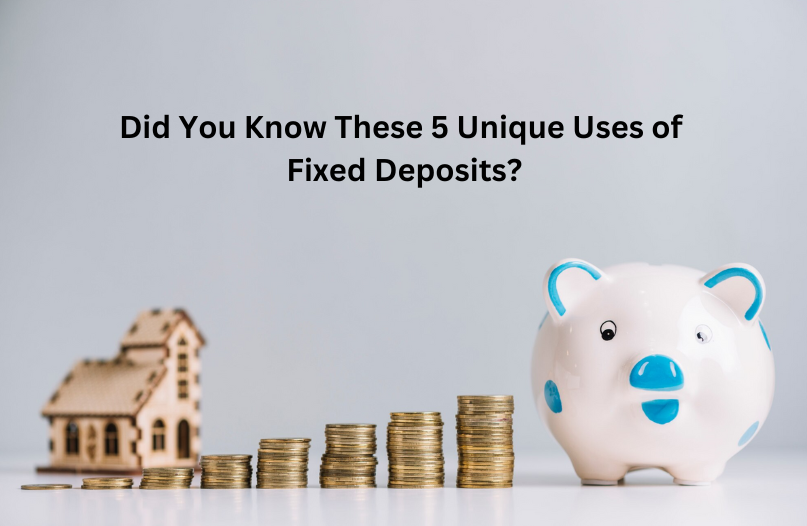I was talking to a friend about investment avenues, and she told me that after doing SIP for about 10+ years, she will now only invest in Fixed Deposits. I got curious and wanted to share my findings with you.
Fixed Deposits (FDs) are often viewed as a straightforward savings tool where you park your money for a fixed term to earn interest. However, beyond this traditional use, FDs can be a versatile component in your financial toolkit.
Table of Contents
5 lesser-known uses of fixed deposits
1. Securing Loans
Many banks offer loans against your FD. This means you can borrow money at a lower interest rate, using the FD as collateral. This may come in handy for children’s education loans or a family emergency.
Advantages:
- Lower Interest Rates: Typically, the rate on the loan is higher than the FD interest rate.
- Convenience: Avoids the need to break the FD prematurely.
Considerations: You keep earning interest on your FD while only paying slightly more on the loan. However, ensure the loan amount and terms suit your financial planning.
2. Laddering Investments
FD laddering involves creating a series of FDs with different maturity dates. Instead of locking all your money in one long-term FD, you spread it across multiple FDs.
Advantages:
- Liquidity: You have funds maturing at regular intervals, providing access to money without penalty.
- Interest Rate Flexibility: If rates rise, you can reinvest at higher rates upon the maturity of each FD.
- Risk Mitigation: Reduces the risk associated with locking into one rate for an extended period.
For instance, with Rs. 5 lakh, you could create five FDs of Rs. 1 lakh each, maturing annually over five years. Think of it as a Systematic Withdrawal Plan (SWP) of mutual funds as a part of fixed deposit strategies.
3. Tax Planning
Some FDs, like tax-saving FDs, qualify for deductions under Section 80C of the Income Tax Act in India, up to Rs. 1.5 lakh annually. You can invest in tax-saving FDs to reduce your taxable income.
Considerations: Interest earned over Rs. 40,000 (or Rs. 50,000 for senior citizens) in a financial year is subject to TDS. However, you can submit Form 15G/15H to avoid TDS if your income is below taxable limits. Also, tax-saving FDs have a lock-in period of 5 years.
4. Retirement Planning
FDs can provide a safe, predictable income stream, crucial for retirement planning through Reverse Laddering. You can invest in longer-term FDs when younger, moving to shorter terms as retirement nears to ensure liquidity.
Inflation Consideration: While FDs offer security, combining them with investments that outpace inflation is wise for long-term planning.
The new-age fintech platforms offer inflation-beating returns in collaboration with NBFCs. However, you should always check their regulatory compliance with DICGC.
5. Auto-Renewal for Hands-Free Management
Many banks offer an auto-renewal feature where, upon maturity, the FD automatically renews for the same term at the then-current interest rate.
Advantages:
- Effortless Management: No need to track maturities and reinvest manually.
- Continual Growth: Ensures your money keeps earning without interruption.
- Adaptation: If rates have improved, you’ll benefit from the new rate without any action on your part.
Considerations: Always check the terms of auto-renewal; sometimes, rates might be slightly less favorable than manual renewals. Also, ensure this aligns with your financial goals, as you might prefer to use the funds or reallocate them.
Certain NBFCs even offer higher interest rates on auto-renewal.
Conclusion
Fixed Deposits are not just about saving; strategic use of fixed deposits includes laddering, securing loans, tax planning, retirement, and hands-free investment through auto-renewal. By integrating these uses into your financial planning, you can make your FDs work harder for you. Always consider consulting with a financial advisor to tailor these strategies to your personal financial landscape.
Remember, while FDs are safe, they should be part of a diversified investment strategy to balance risk and return.
Also read, 5 Non-negotiable Resolutions for Women Seeking Financial Independence
Disclaimer:
This website is created and authored by Bhumica Agarwal and is published and provided for informational and entertainment purposes only. The information in the Blog constitutes the Content Creator’s own opinions (and any guest bloggers posting from time to time) and it should not be regarded as a description of services or recommendations.
The opinions expressed in the Blog are for general informational purposes only and are not intended to provide specific advice or recommendations for any individual or on any specific security or investment product. It is only intended to provide education about the financial industry. The views reflected in the commentary are subject to change at any time without notice.
Nothing on this Blog constitutes investment advice, performance data, or any recommendation that any security, portfolio of securities, investment product, transaction, or investment strategy is suitable for any specific person. From reading this Blog we cannot assess anything about your personal circumstances, your finances, or your goals and objectives, all of which are unique to you, so any opinions or information contained on this Blog are just that – an opinion or information. You should not use this Blog to make financial decisions, and we highly recommend you seek professional advice from someone who is authorized to provide investment advice.
Any indices referenced for comparison are unmanaged and cannot be invested directly. Investments in securities involve the risk of loss. Past performance is no guarantee of future results.
We like to share links to articles and information which is interesting to us. It is in no way an endorsement by us or by anyone associated with us.



